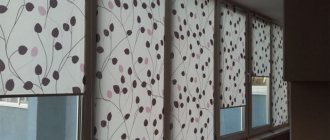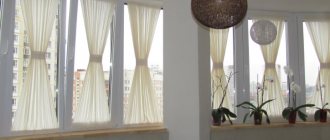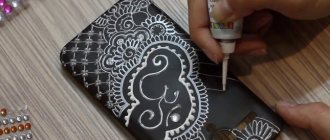Photo: planete-deco.fr Installing a television panel on the wall is one of the most rational solutions that allows you to achieve maximum freedom of space. At the same time, the question arises - how to hide wires that significantly spoil the external aesthetics of the interior? To help you in this matter, we have collected 12 great ideas, among which you will definitely find what you need!
Hiding wires in the wall
At the renovation stage, you can hide the wires from the TV in the wall. To do this, you need to accurately determine the permanent place of “residence” for the television panel.
Next, starting from the intended location of the wire, make a channel in the wall towards the electrical point and lay the cable. Use special construction staples to securely fix it, and then carefully cover it with plaster. Now you can start finishing work.
This method has one significant drawback - the television panel loses its mobility. If you need to move it to another location or send it in for repairs, removing the wire will be very problematic.
Slitting process
Why bother with “disguising” the electrical wiring if you can first attach it to the main wall, and then simply plaster it on top. The technique is called “hidden” and the sequence of actions is not always exactly the same. Most often, a team of plasterers does their job valiantly, and then they are replaced by electricians who begin to reformat the world in their own way, in accordance with the tasks assigned to them. This is strongly reminiscent of the joke about two soldiers from a construction battalion, one of whom was digging holes, and the other was burying them after him (there was no third one, who was supposed to plant trees, but an order is an order). To carry out wiring, electricians are forced to make channels for wires and holes in the plaster with a hammer drill - to punch the surface.
Not everyone and not always want this burdensome procedure:
- Scoring damages existing plaster. It is extremely rare to be able to break through neat channels. And even if this can be done, the final layer of plaster in the areas of gating will still have to be restored after laying the cable. It is worth recognizing that the technique is very multi-iterative.
- Grooving is associated with increased generation of dust, which will be everywhere in the apartment. If we are not talking about the initial arrangement, but about repairs, then you will definitely have to re-glue the wallpaper and update the ceiling.
- Long-term unpleasant sound impact of a hammer drill. Even if you carry out repair work at strictly prescribed hours by law, your neighbors will still not thank you.
- The wiring turns out to be completely hidden. There will never be access to it now.
The purpose of the thesis of this section is not at all to discredit one of the most universal construction technologies that provides great opportunities (slating)
In relation to electrical wiring, I would like to emphasize that the design and aesthetic appeal of the method comes at the price of safety. Electricity is not something to be trifled with, and communications tend to fall into disrepair
It would be good to replace them. But if the wires in the apartment are laid in channels drilled into the wall, then you can simply forget about it. Replacing the wiring is only possible by laying a new cable and disconnecting the old one (at both ends).
In this regard, it would be nice, of course, to get an alternative. There is such a way - it is laying electrical cables in an open way. The features and capabilities of this path are described below.
Masking with a cable channel
Use a camouflage box. With its help you will hide television wires without disturbing the surface of the wall. This structure is fastened with hidden screws and liquid nails.
Today you can purchase a cable channel model that best suits the style of the room. The simplest type is an ordinary plastic box, which after installation can be covered with the same finishing material as the entire wall.
There are models lined with decorative bricks or in the form of pipes, which are ideal for interiors in loft and hi-tech styles. For classic or eco-trends, you can choose wooden or MDF models.
Internal placement
When a major renovation begins in an apartment or house, the wiring is most often recessed into the walls. First, using a wall chaser, drill, or hammer drill, grooves are made in the wall, into which the cables are then hidden. Wiring in a wooden house must be placed in a protective corrugation - a shell that will protect them from adverse effects and prevent damage.
On the walls
It happens that the wallpaper is already pasted, and you don’t want to violate its integrity. There is an option to eliminate protruding cables without causing serious damage:
carefully cut the wallpaper or bend it away from the wall close to the floor; take a convenient construction tool and make a neat shallow channel in the wall; lay the wires in the resulting hole; close the channel with a thin layer of plaster or putty; let the solution dry; glue the wallpaper in its place.
If this method is not suitable, you can proceed without gating - use a decorative box for wires. It is especially common to cover power wires with boxes: they have a large diameter, so they cannot be recessed into the wall without repeated repairs. It is necessary to buy a cable channel that is suitable in color, width, and length, which will serve as an additional decorative element and reliably protect the wiring.
In a wooden house, the box will enhance fire safety measures. This option is also ideal for the bathroom, because it is very difficult to lay wires under the tiles
It is only important to remember that all lighting elements, electrical wiring, and cable ducts must be waterproof
How else to beautifully hide wiring on the walls? If desired, it can be covered with the following finishing elements:
- door frames;
- various moldings, baguettes;
- window slopes.
On the floor
Wiring is often routed along the floor, and here it is even easier to hide it than on the wall. During repairs when laying the screed, you can stretch the cables in corrugation and fill them with cement on top - the communications will be reliable and durable. If there is already a floor covering, it is easy to carefully remove it, punch out recesses with a hammer drill, then push the wires into them and cement them. Under wooden floors, you will have to lay the cables in a metal pipe, after removing the boards.
The stores offer a wide range of floor skirting boards with a hole for wires (with a cable channel). The central part of such a plinth is removed, the cables are laid in the niche, and then the removable element is returned to its place. Working with such skirting boards is convenient, quick, there is no dust, dirt, and the floor material does not deteriorate.
The procedure for laying wires under the most popular coating - laminate - is as follows:
- remove part of the lamellas under which the cable will pass, right down to the construction logs (bars);
- place the cables in the corrugated pipe along or across the joists, if necessary, cutting out space in the wood for the crossing of the wires;
- return the soundproofing pads and lamellas to their original place.
On the ceiling
It is also possible to hide wiring on the ceiling, but the method will depend on the type of coating. In homes and offices, suspended ceilings are often used, which take up excess space, but give the opportunity to route wires as needed by users. There are practically no obstacles for the cables, so it is possible to route them along the shortest path. This has a number of advantages:
- cost reduction;
- reduction of work time;
- reducing the overall circuit resistance;
- strengthening fire safety;
- possibility of easy wiring replacement.
According to fire safety rules, wires and their bundles must be covered with corrugated pipes. The same applies to wiring under suspended ceilings, niches or complex plasterboard structures. It is best to connect communications into a single highway, which will facilitate repairs in the future. If the ceiling is concrete, you will have to drill grooves in it and lay wires in the same way as is done on the walls. This method is very labor-intensive and is rarely practiced.
Hiding behind drywall
Drywall is widely used in the design of modern interiors, as it allows you to mask surface imperfections and create original decorative designs. Why not take advantage of this?
Come up with a wall structure, for example, in the form of a plasterboard box with niches, shelves and, of course, space for a television panel. After installation, all wires will be securely hidden, and the interior of the room will become more stylish and functional.
You can build a false fireplace from drywall and install a TV above it. This way you will get a great seating area, and the wires will be securely hidden.
Installation of the junction box
There are some nuances here too. It’s worth starting with the fact that in rooms with concrete walls it is recommended to use diamond-coated drill bits, since the more common models with pobedit coating wear out quickly, and you will have to buy additional drills. They can only be used in houses with walls made of finblocks. Typically, when working with finblocks, it is prohibited to use diamond-coated crowns for the same reasons.
Before milling begins, a hole with a diameter equal to the drill is made in the center of the installation, which will make the work much less difficult. Experts recommend choosing boxes with a diameter of 6-7 cm; this will be quite enough for 6 cores. If you plan to connect several sockets in a row, the place for them is leveled.
How to hide wires in furniture
The TV can be installed in a wall set, which will hide all communications in its depths. But if you don’t like bulky structures, use modular elements, such as a wall cabinet.
Many modern models of such furniture already have special holes in their design into which wires are laid.
Stretch ceilings in the interior of an apartment (200 photos)
Drywall niche for TV: 75 photo ideas
A new TV is always good, but with it the question inevitably arises of where to put it. Cabinets, brackets, furniture sets with special compartments, stands and hanging shelves - among the assortment of stores, one’s eyes run wild. But what to do if you don’t want to clutter the room with unnecessary furniture? There is a solution: a neat and elegant plasterboard niche! And we will help you figure out where to place it and how to make it yourself.
Wire panel
If you are a creative person, come up with some kind of wall drawing, the contours of which you will draw with wire. You can find quite a lot of such ideas on the Internet!
Draw a sketch on the wall with a pencil and start laying. Don’t forget that the pattern or geometric figure should fit harmoniously into the interior.
An important point is the method of fixation. Nails are not suitable for this work - they can damage the cable and spoil the design with their unaesthetic appearance. Therefore, use double-sided tape or glue.
Decorating a wall with panels
Instead of furniture covering the wall, you can make a decorative panel from 3D panels, natural wood, chipboard, or laminate. This method will be very relevant for narrow rooms, where every centimeter counts.
The design is easy to make yourself. To do this, you need to prepare a frame on the wall for mounting the panels. It is important to properly strengthen the place for fixing the bracket. Otherwise the screen will end up on the floor.
Decorative panels are fixed to the frame, and a wire is run between them and the wall. LED lighting around the edges will make this solution much more interesting.
Masking with vinyl stickers
Interior vinyl stickers are an excellent decorative material. Its main advantage is that it allows you to quickly transform the interior and emphasize style. At the same time, such decor can be removed or replaced with a new one at any time without any problems.
Use vinyl stickers to create decorations where the TV cable is located. It could be a branchy tree, with the crown of which the cable will blend into the color palette.
Techniques for conducting and hiding wiring in an apartment
The two most well-known methods of wiring in an apartment: hidden and open. The first, as stated above, involves grooved walls and ceilings.
At the same time, at the time of laying the wires in the grooves, for protection and to ensure the convenience of further work, the wiring is pulled through the corrugation. Having secured it in the recess along the entire line of the excavation, plastering work is carried out. Align the places where the corrugation is laid and then carry out the usual finishing work (putty and painting or wallpapering).
Unlike the hidden type, the open type is based on the visible distribution of wiring throughout the apartment. This method of arranging wires along surfaces can be used in the event that a certain old section of wiring is blocked or if it is necessary to carry out a specifically open form of electrical wiring.
Here, instead of corrugation, plastic electrical boxes (cable channels) of various sections are used, which are mounted on the surface of the walls vertically or horizontally. The wiring is located inside the cable.
Wires behind a wooden panel
Installing a wooden panel with a TV will not only adequately highlight the design of the room, but will also become an excellent camouflage element that will allow you to hide the wires.
Wooden panels can have a different color palette and shape, adding sophistication and presentability to the interior. In addition, the material will serve as a good sound insulator, so you won’t have to worry about the indignation of picky neighbors who are dissatisfied with the increased volume.
60+ beautiful narrow bedroom design ideas (photos)
Make them part of the decor
Yes, if it’s too late to come up with global restructuring, you can get out of it in a more creative way. Don't hide the wire, but decorate the room with it! Sounds weird? Maybe, but it looks great. So wires can become part of a futuristic interior if they are mounted on the wall along with the equipment. An excellent option for the room of a teenage boy who is interested in computer games. With interesting lighting the effect will only increase.
Also, the wires themselves can be hidden inside metal pipes. And the pipes will perfectly complement the loft style. Don't be shy about using items that have already been used. They will only add charm to the interior. In general, the lack of large funds to solve this issue is not such a big problem. You just need to use your imagination.
Another option is not just to draw a tree, but to make it 3D. That is, stick colored figures of birds, leaves and flowers on the wall. Such sets can be found on the Internet or cut out yourself. This idea is best suited for children's rooms.
Branches of dry and artificial plants
Wires from the TV can also be hidden using branches of artificial plants. Place a vase with dry twigs near or under the TV panel and all attention will shift to an attractive-looking composition.
You can use special wire covers in the form of branches, which are quite similar in design to cable channels, but at an aesthetic level they are much superior. Such functional decor will look great in a children's room.
What you need to know when working with TV cables
First of all, you need to remember the safety requirements for electrical installation and pay attention to the following aspects:
- all work must be carried out with the equipment turned off;
- use tools only with insulated handles;
- monitor the integrity of the cable insulating coating;
- do not allow wires to rub against sharp edges of furniture;
- exclude exposure of the cable sheath to high temperatures;
- avoid tangling of wires, their kinks and crushing by heavy objects;
- prevent moisture and condensation from entering the cable channels;
- The TV cable should not intersect with power lines.
You can decorate the wires with a decorative box.
What conclusion can be drawn from all this - for a person with hands and imagination, nothing is impossible, and there is no limit to perfection. The main thing is to carefully plan everything, stock up on the necessary tools, materials and get to work.
Don't forget to follow safety standards.
Wires in “ethnic” style
If the interior of your TV room is decorated in an ethical style or you simply like to surprise with the “quirks” of the interior, take note of the option of masking wires with beads. Of course, you will need fairly large parts that will fit freely on the cable.
Pay attention to the selection of colors - you can choose plain details to match the color of the wall or contrasting ones that attract attention. White and red beads are suitable for wallpaper in warm colors, and blue, green and black - in cold colors.
Secure the wires under the tabletop
To secure the wires and extension cord under the table, you will need binders and screws (their length should be at least a quarter less than the thickness of the table top, otherwise they will go right through and the table will be damaged). First of all, attach an extension cord under the tabletop, preferably in the middle of the table or closer to the wall. Then secure the binders in the required places using screws. Connect everything you need to the extension cord and collect the wires with clamps. Visually the table has become much cleaner and neater.
Stapler clips aren't your thing? Regular zip ties will do. Secure the wire to the table leg with zip ties. Wires that run along the floor can be covered with plastic or a board that matches the color of the floor. The extension can be secured under the tabletop using wide Velcro: secure it to the back of the tabletop with screws, and then attach the extension. To prevent wires from dangling under the table, run them through cable channels - they can be purchased at any hardware store. You can fix the channels themselves with electrical tape or a regular plaster.
Hiding wires with threads and ropes
Another simple way to hide TV wires is to wrap them with colored threads, ribbons or jute rope.
You can choose one of several design methods. For example, simply twist the wire or braid it with a pigtail. The color of the material should be in harmony with the surrounding environment.
Suspended ceilings: 100 design ideas (photos)
Features of the TV location
It is best to ask this question in advance, think through and design the installation of the device and its terminals. The standard rule is one TV outlet and three regular outlets behind the plasma monitor. They connect the TV itself, an Internet adapter, an Xbox or another game console if necessary.
All these outputs will be securely hidden behind the plasma monitor; the sockets must be installed 9-12 cm above or below the edge of the plasma.
If there is a TV stand under the plasma, on which you can place other types of equipment, then sockets behind it will also not hurt.
At a height of 40 cm from the floor covering, place a single block of 3-4 sockets, even if they are not useful now, it is better to be safe for the future. Extra sockets will eliminate problems with wires, cables and additionally included carriers.
How to properly hide the wires coming from the TV on the wall if the renovation has already come to an end? When the repair is complete, all cables can be carefully hidden in a box with a niche and carefully secured to the TV. Then it all depends on your imagination and preferences in decorating the box for the interior item. It can be disguised to match the color of the wall, wallpaper, or, conversely, highlight it with a bright shade.
When television equipment is located opposite a window, it is necessary that the light does not block the picture on the screen. In this case, thick fabric or electric curtains will help. In the second option, you need to prepare another socket in the place where the electronic curtain will hang.
Not all TV models are attached to a wall surface: a lot depends on the model, the weight of the equipment and the material of the wall surface. It is also important to consider the quality and reliability of the fastening bolts. The wall must be strong and able to support the weight of the TV. Ideally, the equipment is attached to a brick or concrete wall.
If the TV will be on a bedside table or coffee table, then the sockets directly behind it are perfect for discreetly plugging them into the network.
Use books and magazines
Even books can be good helpers in trying to hide television wires. Try to choose ones that have a neat, aesthetic appearance or with bright covers.
Books and magazines can be stacked on a table or shelf under the TV. Pick up a couple of high-end editions that will reach all the way to the television panel. Don't overdo it with the quantity - keep it small so as not to create a mess.
Use of furniture
The simplest thing is to install a chest of drawers or a cabinet under the TV. Moreover, it is better to choose a furniture height so that the wires can be easily hidden from view by decorative elements. A vase, a photo frame, a fresh flower.
A great option is to make custom-made furniture with a niche for a TV. The screen can be located between the wardrobe doors, or located among open shelves. It is both beautiful and practical.
Phytostena
Installing a phytowall is a stylish solution for any modern interior. It is a large panel with “pockets” in which plants are placed. Installing a TV in such a frame has many advantages, one of which is the ability to hide the wires.
In addition to the fact that the design of the room will not be disturbed by the carelessness of a hanging cable, you will be able to enjoy watching your favorite TV shows surrounded by clean, humidified air, which is important for a city dweller!
Plasterboard niche for TV in the living room
It is almost impossible to imagine a modern living room without a large TV. Even strict opponents of television do not deny themselves the pleasure of showing their favorite films or clips on the screen.
But finding a comfortable place even in a spacious living room is not always easy, because you still need to fit a sofa, table, cabinets, work area, shelves and books, musical instruments and a lot of other little things. Therefore, modern ergonomic designs come to the fore.
Plasterboard niches can easily replace old, clumsy walls. They will also help you organize space correctly, because it is a powerful tool for visually zoning a room.
Plasterboard niche for TV in the bedroom
The bedroom is an atmosphere of peace, relaxation and comfort, where there is no room for anything unnecessary. And this is not a whim at all, because your well-being, mood and performance directly depend on healthy and full sleep.
Don’t clutter your bedroom with unnecessary furniture and appliances - and calm and romance will always reign in it. But this doesn’t mean you need to give up a new episode of your favorite TV series before bed.
A plasterboard niche in the bedroom is not only an ideal place for a TV that will not get in the way, but also a stylish, atmospheric accessory. Elegant decor, gentle dim lighting, fresh flowers or favorite photographs around - and the bedroom will be transformed.
Plasterboard ceilings in the interior (150+ photos)
Plasterboard niche for TV in the kitchen
Functionality always comes first in the kitchen, because it is the main workroom in any apartment. But a TV won’t hurt either, because it makes it more fun to do routine things and more enjoyable to spend time with your family watching your favorite films.
But when installing a TV in the kitchen, the most difficult thing is to choose a place. It is important that it does not interfere, is not too close to the stove or sink, so that water and grease do not get on it, and that the protruding structure does not interfere with the passage.
Most often, the kitchen area is limited and not too large, so there is no talk of any cabinet cabinets. Putting the TV directly on the work surface between the food processor and the microwave oven is far from the best option, so a plasterboard niche comes to the rescue.
Video: How to make a niche for a TV from gypsum board
Did you like the post? Subscribe to our channel in Yandex.Zen, it really helps us in our development!
Internet site with useful tips and ideas for life. All rights to photographs belong to their authors. When using materials from this resource legally, a hyperlink to LAFOY.RU is required! Materials, oh, are published as advertising.
The Site may contain content not intended for persons under 18 years of age. About the project Copyright holders Contacts Our channel: Yandex.Zen
Source
Illumination of a plasterboard niche
Lighting is a stylish and convenient tool for decorating plasterboard structures and niches. From the point of view of ease of installation and fire safety, mounted spotlights and LED strips have proven themselves to be the best. Duralight, neon tubes and threads are good for creative interiors.
Direct the light stream away from the room, otherwise it will be too bright. The most comfortable shades for vision are white and yellow, and colors can be added with blue, green or red neon. But it is not recommended to keep colored or flashing tapes on all the time: they strain the eyes.
Drywall arches (100 photos): design ideas
Don’t rush into arranging a plasterboard niche for a TV: first analyze all the variety of options, and only then choose the ideal solution. To do this, we offer you our selection of photographs with real interiors!











